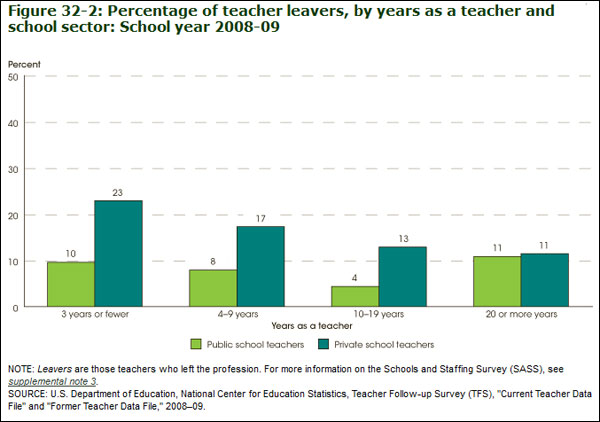High U.S. educator turnover rates stem in part from reasons such as burnout, the increasing threat of budget cuts and layoffs, an average starting salary of $35,000, more reliance on standardized testing and poor working conditions. There is a vast amount of research on the issue of teacher turnover and how it affects, in particular, urban school systems. Some research has shown that high-poverty urban schools lose as much as 22% of their faculty in a given year; this in turn harms student achievement. Qualitative studies have suggested that teachers in such situations often leave because of lack of school support, not necessarily because of challenging students. Whatever the reason, 15 percent of public school teachers across all districts nationwide left their positions after the 2007-2008 school year — 8% left the profession altogether, and 7% went to other schools — and the rate has subsequently risen.
A factor in teacher attrition that has received little attention is the gender dynamics of school districts. Some policymakers suggest that gender congruence — or same-sex matches — between student and teacher improves student performance and that the recruitment and retention of male teachers is one of the best methods of closing the gender achievement gap. Although women comprised more than 76% of public school teachers, according to a 2011 government report, they represented 59% of primary school and 29% of secondary school principals in the United States as of 2008. To what extent do these dynamics influence who remains in the classroom, and who chooses to leave?
A 2012 study from Vanderbilt University and the University of Missouri published in the Journal of Public Administration Research and Theory, “Does My Boss’ Gender Matter? Explaining Job Satisfaction and Employee Turnover in the Public Sector,” looks at the relationship between principal gender and gender congruence, and teacher satisfaction and turnover. Researchers obtained data from the Department of Education’s Schools and Staffing Survey (SASS) from 2003-2004, as well as the 2004-2005 Teacher Follow-Up Survey (TFS). The data does not differentiate between voluntary and involuntary turnover or account for turnover intention.
The study’s findings include:
- Women are less likely than men to leave their teaching positions, and the data consistently suggest that more teachers, regardless of gender, prefer working for male principals.
- Male teachers working under female principals experienced turnover rates 4 percentage points higher than did male teachers with male principals, and 5 percentage points higher than the turnover rate for female teachers working under either male or female school leadership.
- Male teachers were less satisfied and more prone to leave a teaching position when the principal was female. Satisfaction levels were the same for female teachers working under both male or female principals and male teachers working under male principals: “In organizations where men are the minority, gender congruence matters and more so for men than women.”
- The researchers offer several explanations for the relatively negative outcomes when male teachers work for female principals: “Perhaps women manage men differently from women in important ways, or perhaps they do not manage men differently but would benefit from doing so. Alternately, perhaps male teachers are less willing to accept women as leaders or, more accustomed to men in positions of authority, have a hard time adjust[ing] to work situations in which gender incongruence is present.”
- The findings of the study were still valid even when researchers took into account broad differences among schools in terms of the income levels of student households, school performance, staffing levels and student population.
The authors note that as more men venture into occupations traditionally viewed as “female work” such as teaching, social work and nursing, gender congruence merits additional study. It is also unclear from the study the extent to which educators who leave a school leave the profession or continue to teach at another school. For more detail on how experience factors into the decision to leave, see this U.S. Department of Education chart:

Related research: A 2011 study from Columbia and Harvard stands as of the most comprehensive examinations of the value of teachers for students over their lifetimes. Further, a 2013 study, “Going Beyond Reading, Writing, and Arithmetic: The Effects of Teacher Representation on Teen Pregnancy Rates,” found that schools with at least 20% of African-American teachers saw African-American pregnancy rates plummet. “Our interviews indicate that African-American teachers serve as mentors, take a special interest in the behaviors and decisions of African-American students, and actively try to have an influence on them,” write the researchers, from the University of Tennessee and the University of Georgia. “… Similarly, the priorities and policies of the school are influenced by the presence of African-American teachers. Finally, African-American teachers serve as role models for African-American students, which can encourage students to make healthy decisions regarding sexual activity.”
Tags: women and work, African-American, teachers


Expert Commentary